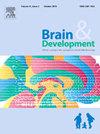Genetic analysis of leukodystrophies in children: towards improved diagnostic yield
IF 1.3
4区 医学
Q4 CLINICAL NEUROLOGY
引用次数: 0
Abstract
The formation of the myelin sheath in the central nervous system is carried out by oligodendrocytes, and leukodystrophies develop when myelination by oligodendrocytes is impaired. It has been found that the activity of the neurons undergoing myelination is also necessary for complete myelination, meaning that not only abnormalities in oligodendrocytes but also abnormalities in neurons can lead to defective myelination. Many genes involved in leukodystrophy in children have been identified, and comprehensive genetic analysis has been proven useful for genetic diagnosis. However, target panel sequencing, exome sequencing targeting almost all exons, and genome sequencing does not identify the genetic cause in substantial proportion of patients, making it essential to advance research targeting these unresolved cases. Transcriptome analysis has been reported to improve diagnostic rates in individuals with suspected Mendelian conditions, by confirming aberrant splicing caused by candidate DNA variants or by revealing candidate loci through detecting abnormalities in RNA transcription. Because transcription has a tissue specificity, selection of tissues from which RNA extract is of importance. In this mini-review, we first briefly review genetics of leukodystrophies in children along with methodology of genetic analysis, and discuss utility of urine-derived cells for transcriptome analysis of leukodystrophy in children.
儿童脑白质营养不良的遗传分析:提高诊断率
中枢神经系统髓鞘的形成是由少突胶质细胞完成的,当少突胶质细胞的髓鞘形成受损时,就会发生白质营养不良。研究发现,发生髓鞘形成的神经元的活性对于完整的髓鞘形成也是必要的,这意味着不仅少突胶质细胞异常,而且神经元异常也会导致髓鞘形成缺陷。许多与儿童脑白质营养不良有关的基因已被确定,全面的遗传分析已被证明对遗传诊断有用。然而,靶板测序、针对几乎所有外显子的外显子组测序和基因组测序并不能确定大部分患者的遗传原因,因此有必要针对这些未解决的病例推进研究。据报道,转录组分析可以通过确认由候选DNA变异引起的异常剪接或通过检测RNA转录异常来揭示候选位点,从而提高疑似孟德尔病症个体的诊断率。由于转录具有组织特异性,因此选择RNA提取的组织是很重要的。在这篇小型综述中,我们首先简要回顾了儿童白质营养不良的遗传学以及遗传分析的方法,并讨论了尿源性细胞在儿童白质营养不良转录组分析中的应用。
本文章由计算机程序翻译,如有差异,请以英文原文为准。
求助全文
约1分钟内获得全文
求助全文
来源期刊

Brain & Development
医学-临床神经学
CiteScore
3.60
自引率
0.00%
发文量
153
审稿时长
50 days
期刊介绍:
Brain and Development (ISSN 0387-7604) is the Official Journal of the Japanese Society of Child Neurology, and is aimed to promote clinical child neurology and developmental neuroscience.
The journal is devoted to publishing Review Articles, Full Length Original Papers, Case Reports and Letters to the Editor in the field of Child Neurology and related sciences. Proceedings of meetings, and professional announcements will be published at the Editor''s discretion. Letters concerning articles published in Brain and Development and other relevant issues are also welcome.
 求助内容:
求助内容: 应助结果提醒方式:
应助结果提醒方式:


